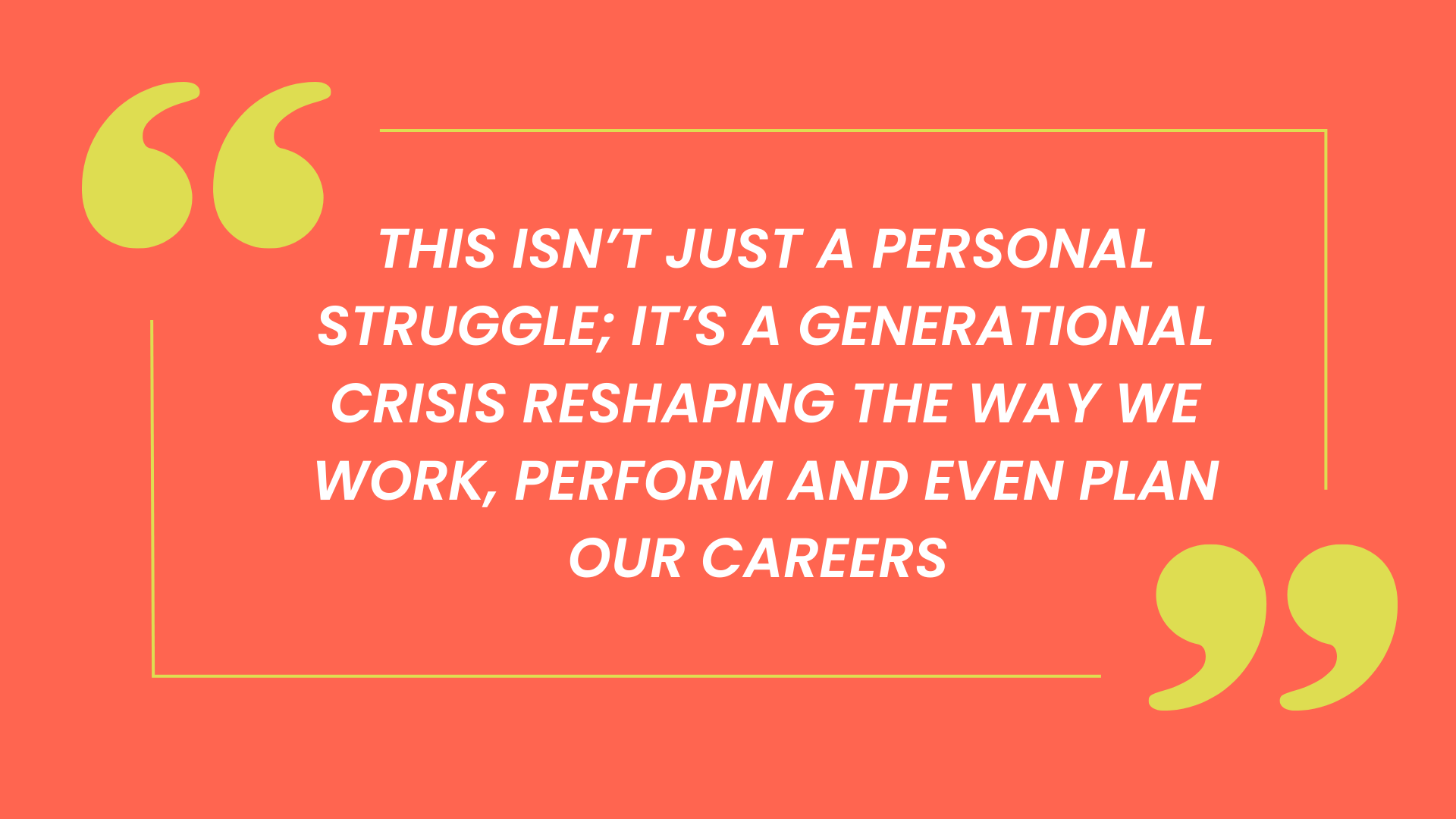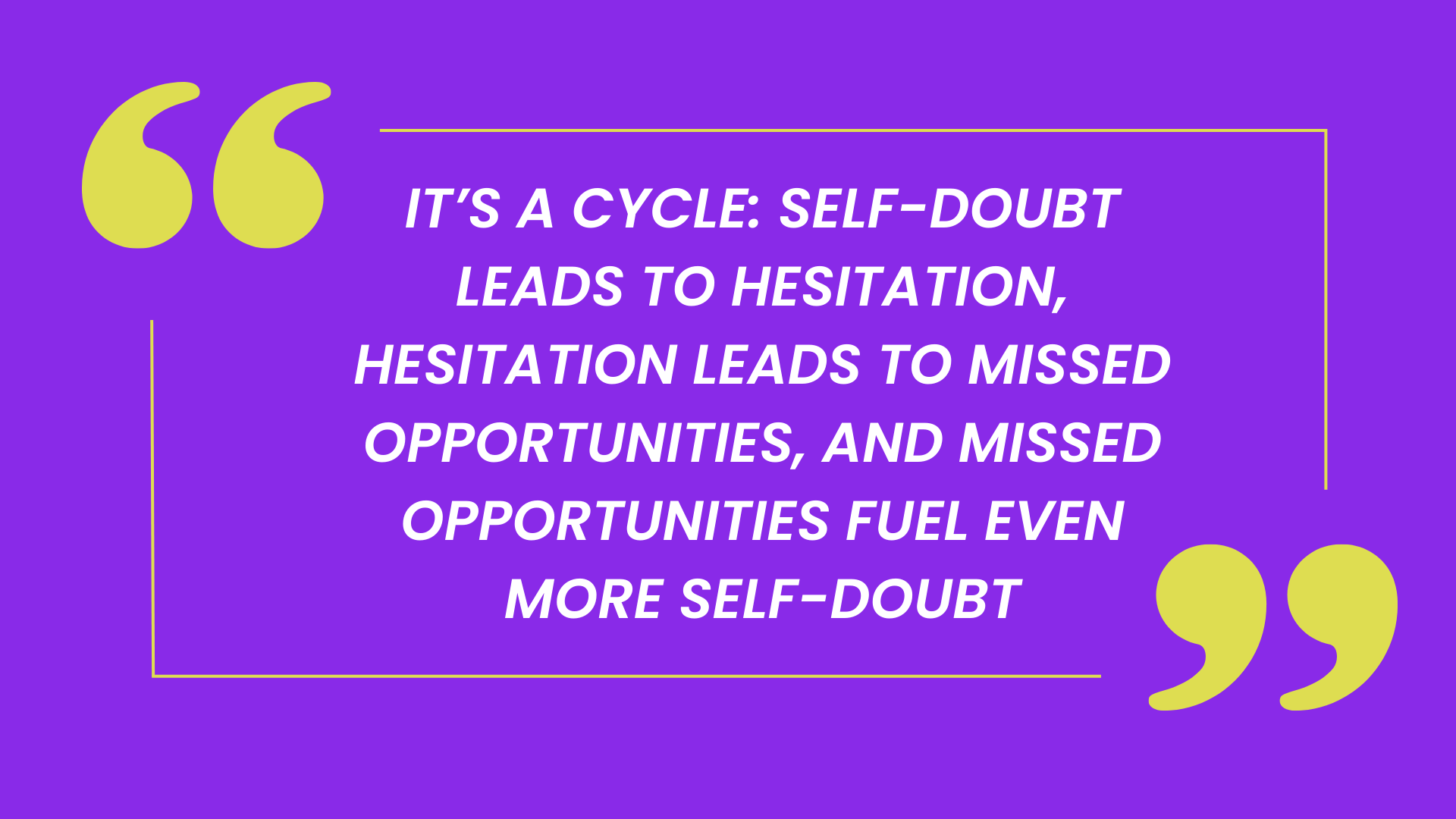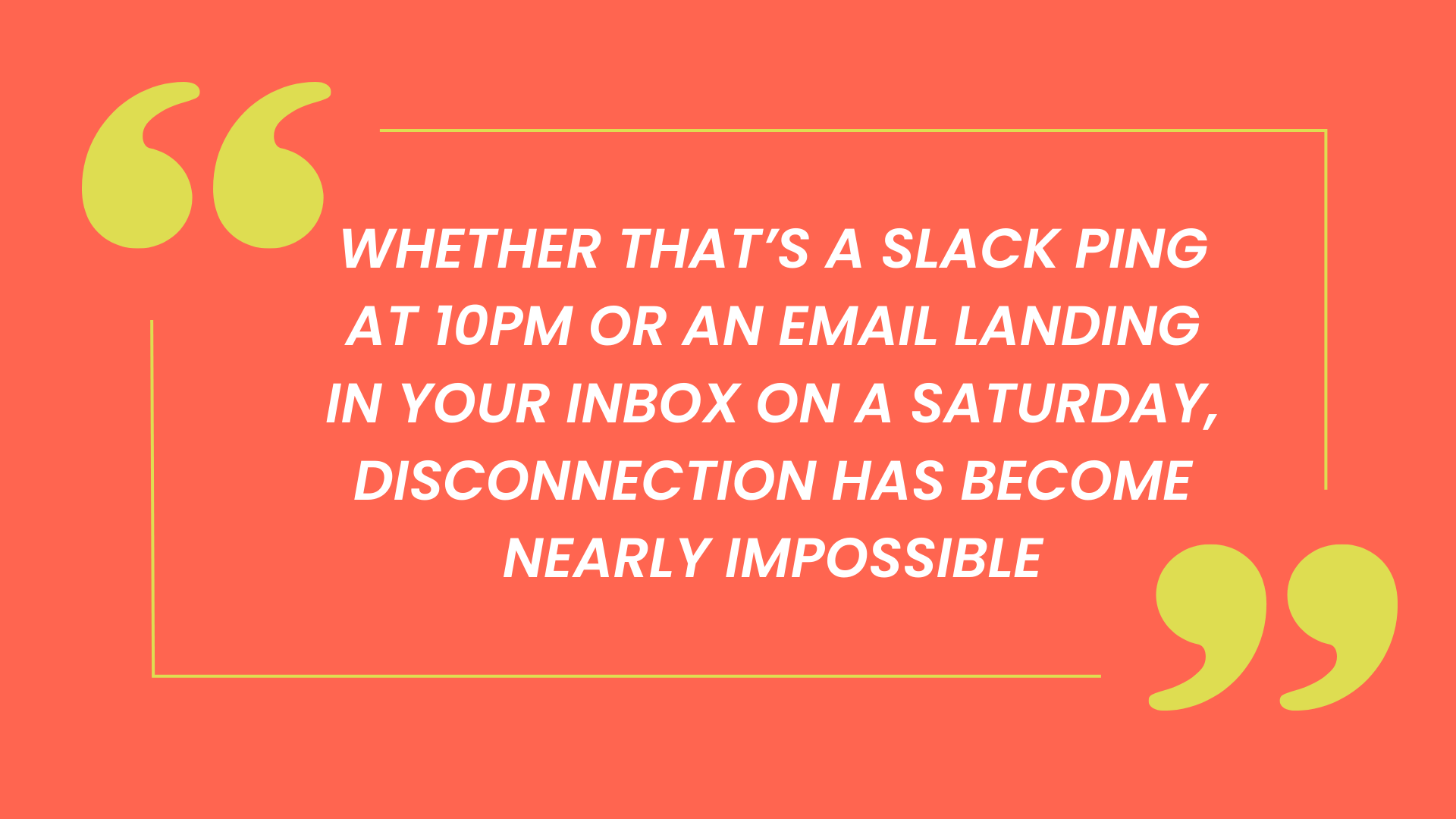It’s 2025, and before you’ve even had your morning coffee, your phone is already buzzing. Emails, Slack messages, calendar invites – it’s all there, demanding your attention before you’ve even brushed your teeth. Then comes the inevitable doom scroll, where you find an old school friend just bagged a promotion, someone else is launching a startup, and another is somehow balancing it all with the perfect wellness routine. Meanwhile, you’re drowning in deadlines, battling imposter syndrome and wondering if you’ll ever catch up.
Sound familiar? You’re not alone.
Workplace stress is hitting hard, especially for younger generations. In fact, 40% of Gen Z and 35% of Millennials say they feel stressed or anxious most of the time, while a staggering 98% of Gen Z are showing symptoms of burnout. But this isn’t just a personal struggle; it’s a generational crisis reshaping the way we work, perform and even plan our careers.
But why is it hitting younger professionals so hard?
In this post, we look at the factors contributing to workplace anxiety, how it can impact performance and long-term career growth, generational differences in coping with workplace stress, and how to best manage anxiety in high-stress tech roles.

What’s Contributing to the Rise in Workplace Anxiety?
The professional landscape has undergone one ginormous shift, and no generation has felt it more than Millennials and Gen Z. Unlike Baby Boomers and Gen X, who worked in structured environments with clearer work-life boundaries, younger employees are navigating a world of constant connectivity, digital overload, economic uncertainty and relentless competition.
Take social media, once a tool for networking and opportunity, has evolved into a 24/7 highlight reel. Every scroll serves up endless curated success stories that fuel comparison and self-doubt. According to a 2023 Deloitte report, 46% of Gen Z and 40% of Millennials feel inadequate due to social media, and 45% of Gen Z and 40% of Millennials feel pressured to maintain an online presence.
Then, there’s the reality of never really logging off. The rise of hybrid and remote work means that the office is everywhere, and so is the pressure to be available. Whether that’s a Slack ping at 10pm or an email landing in your inbox on a Saturday, disconnection has become nearly impossible. In fact, online communication fatigue has become such a growing issue that 60% of people experience high stress and burnout due to constant connectivity. Microsoft’s Work Trend Index also reports that 50% of Gen Z feel burnt out from digital communication overload, and 70% regularly check work messages outside of office hours.
Beyond digital exhaustion, financial insecurity plays a massive role in the anxiety crisis. Millennials entered the workforce during a recession, while Gen Z are stepping into an economy marked by inflation, job instability, and the looming threat of AI automation. This fear of being replaceable fuels a relentless push to overperform, upskill, and prove one’s worth – often at the cost of mental wellbeing.
And the numbers don’t lie… According to the World Health Organization, work-related stress costs the global economy an astronomical $1 trillion annually in lost productivity. Among Gen Z, 80% worry about job security, while Millennials are twice as likely as Boomers to work unpaid overtime just to stay ahead.
Plus, financially speaking, younger generations are far behind where their parents were at the same age. With less savings, less home equity and higher student debt, long-term financial stability feels increasingly out of reach. While previous generations could expect stable employment, steady career progression and a comfortable retirement, today’s workforce faces a harsher reality: one where simply having a degree is no longer enough. Instead, there’s a relentless pressure to optimise, upskill and constantly prove their value in an unpredictable job market.

How Do Different Generations Cope with Workplace Stress?
Anxiety doesn’t play favourites. It affects people of all ages, but the way it shows up and how it’s dealt with can differ wildly depending on which generation you belong to. Each generation brings its own values, experiences, and coping mechanisms to the table, and right now, Millennials and Gen Z seem to be feeling the pressure the most.
Studies show that over 50% of young workers report feeling anxious about stress they’ve experienced in the last month – way higher than the national average of 34%. As younger generations step into a job market that’s more competitive, demanding, and, let’s face it, uncertain than ever, anxiety is quickly becoming a major roadblock to career growth.
So, how does each generation handle stress in the workplace?
Baby Boomers and Gen X: The ‘Grin and Bear It’ Era
Baby Boomers and Gen X (born between 1946 and 1980) entered a workforce that was much more structured and predictable, where career paths were more straightforward, work-life boundaries were clearer, and job security was more of a given. Back then, you could shut your computer off at the end of the day and truly disconnect. At this time, mental health wasn’t exactly a boardroom topic. Instead, the expectation was to push through, keep your head down, and not let stress get in the way of performance.
These generations were all about embracing the ‘grin and bear it’ mentality because asking for help with stress? Well, that was a personal matter, not something you brought to the office. Seeking support or accommodations wasn’t the norm, and for many, admitting to anxiety felt like a career risk.
Millennials and Gen Z: The ‘Always On’ Generation
Fast forward to today, and Millennials and Gen Z (born between 1981 and 2012) are navigating a workplace that’s anything but predictable. They’re facing constant change, digital overload and a job market that feels way more unstable. Global crises, like climate change and political turmoil, aren’t just distant headlines; they’re everyday stressors. Financial stability feels like a pipedream, and social media fuels the comparison game. For younger employees, the pressure to ‘keep up’ is real. Unlike their older counterparts, who could log off and leave work at the office, Millennials and Gen Z are ‘always on,’ juggling work emails, Slack pings, and Instagram stories 24/7.
At the same time, these younger generations grew up in a world where conversations on mental health are everywhere, from social media to school curriculums. They’re more open about their struggles and are driving demand for workplace policies like mental health days, flexible schedules, and wellness initiatives. But there is one catch: just because we talk about mental health more candidly doesn’t mean we always benefit from it.
Mark Beal, a Rutgers professor and author of Decoding Gen Z, sums up the shift this way: Boomers and Gen Xers “live to work,” while Millennials and Gen Z “work to live.” A 2023 Deloitte study backs this up, showing that 86% of leaders see their job as a central part of their identity, while only 61% of Gen Z workers agree. This mindset shift is leading to a big push for workplace wellness, and while it might ruffle some feathers with older generations, it’s ultimately creating an environment that truly supports employees’ well-being, cultivating a healthier, more engaged workforce across the board.

How Can Anxiety Impact Workplace Performance?
You’re in a meeting, heart pounding as your manager calls on you for input. You’ve got ideas – good ones – but the words stick in your throat. Instead of speaking up, you nod along, hoping someone else will say what you were thinking. Later, you replay the moment in your head, frustrated with yourself – why didn’t I just say something?
This is workplace anxiety in action. It’s not just pre-presentation jitters or the occasional Sunday night dread. It’s a constant undercurrent that can shape your decisions, behaviours, and, over time, your entire career trajectory.
Research from the Anxiety and Depression Association of America highlights just how deeply anxiety can impact work life. The study found that more than half of employees who experience anxiety say it directly impacts their work performance, leading to struggles with problem-solving, deadlines, meetings, and even maintaining professional relationships. When anxiety becomes a constant companion at work, it can lead to second-guessing decisions, avoiding challenges, and ultimately holding yourself back from growth opportunities.
And the thing is, it’s a cycle: self-doubt leads to hesitation, hesitation leads to missed opportunities, and missed opportunities fuel even more self-doubt. Meanwhile, those who push past their discomfort seem to be moving forward effortlessly, leaving you wondering if you’re falling behind.
But anxiety doesn’t just affect individuals; it ripples across entire businesses, too. A disengaged, overwhelmed workforce leads to lower productivity, increased absenteeism, and higher turnover rates. The good news is that more companies are waking up to the reality that mental wellbeing isn’t just a personal issue; it’s a business imperative. Yet, despite this, many professionals still feel the need to hide their struggles, fearing that acknowledging anxiety could be seen as a weakness and stall their career progression.

What Effects Does Anxiety Have on Long-Term Professional Development?
For many people, anxiety doesn’t just impact the day-to-day grind; it can shape their entire career path. For example, when faced with opportunities that involve public speaking, decision-making, or leadership responsibilities, employees with anxiety can often avoid taking the leap. And it’s not because they lack the ambition or drive. It’s the fear of being judged or failing in high-pressure situations that can leave them questioning if they’re cut out for the role.
For some, even considering a career move can feel overwhelming. Just imagine landing your dream job, only for the idea of adapting to a new environment or meeting new colleagues to trigger a wave of anxiety. It’s a scenario that’s all too familiar for those who live with constant worry.
Social anxiety, in particular, can be a major roadblock to career progression. As Dr. Annie Zimmerman explains, people with social anxiety spend so much mental energy managing interactions that they might avoid certain scenarios like networking events, leadership roles, or even speaking up in meetings. And in workplaces that reward confidence over competence, that puts those people at a serious disadvantage.
Dr. Tomas Chamorro-Premuzic, author of Why Do So Many Incompetent Men Become Leaders?, argues that hiring processes often favour extroverted, self-assured individuals – sometimes at the expense of actual skill. In fact, research finds that 97% of recruiters prioritise “cultural fit” when hiring. On the surface, that makes sense: we all want to work with people we click with. But for job seekers with social anxiety, it can mean being overlooked simply because they don’t fit the mould of an outgoing, charismatic candidate.
And this impact goes beyond the hiring stage. A study by the Sutton Trust found that extroverted employees are 25% more likely to land high-paying jobs, with the gap even wider for men. If workplaces continue to equate leadership potential with confidence alone, how many talented professionals are being sidelined because they don’t fit traditional expectations?
The reality is, not everyone thrives in environments designed for the loudest voices. And while introversion and social anxiety aren’t the same thing, they often come with overlapping challenges. Dr. Chamorro-Premuzic calls it ‘introversion tax,’ where employees who aren’t naturally outspoken have to work harder to be noticed, respected and promoted.
So how do we fix this?
It starts with redefining what leadership and success actually look like. Strong leaders aren’t always the loudest in the room, and valuable contributions don’t have to come in the form of confident speeches. By recognising and rewarding different working styles, companies can create a culture where talent isn’t just measured by how well someone performs in an interview or how effortlessly they network at a company event.
At the end of the day, a truly inclusive workplace isn’t just one that talks about mental health; it’s one that actively supports different personalities, work styles, and ways of coping with stress. That’s not just good for employees; it’s good for business, too.

How Can You Best Manage Anxiety in High-Stress Tech Roles?
Tech is an industry built on speed, innovation, and constant change, but that pressure can come at a cost. Long hours, ambitious targets, and the ever-present fear of falling behind can create the perfect storm for anxiety. While some stress is unavoidable, how you manage it can make all the difference. Here are our top five tips to help navigate high-pressure environments without burning out:
1. Reframe Anxiety as a Strength
Anxiety isn’t just a hurdle. It can be a sign of deep thinking, strong attention to detail, and high emotional intelligence. Many of the qualities that make someone prone to anxiety also make them great problem-solvers and leaders. Instead of seeing anxiety as something to ‘fix,’ try shifting your perspective: How can your self-awareness and thoughtfulness work to your advantage?
2. Set Boundaries (and Stick to Them)
In an age where Slack messages and emails never stop, setting boundaries is crucial. Whether it’s turning off notifications at 6pm, blocking focus time in your calendar or communicating when you’re at capacity, small changes can prevent stress from creeping into every corner of your life. And remember, overworking isn’t a badge of honour!
3. Practice ‘Strategic Visibility’
For those who struggle with social anxiety, speaking up in meetings or networking can feel overwhelming. Instead of forcing yourself into high-stakes interactions, find ways to contribute that play to your strengths. Share your insights in writing, follow up with well-thought-through emails, or schedule one-on-one conversations that can be just as effective as speaking up in a crowded room.
4. Recognise When It’s Time to Step Away
Tech thrives on urgency, but not every request is an emergency. Learning to step away – whether that means taking an actual lunch break, going for a walk, or actually using your annual leave – can help reset your stress levels and improve long-term performance. After all, burnout doesn’t lead to better work.
5. Push for Workplace Change
If anxiety is affecting you, chances are you’re not the only one. Advocate for workplace policies that support mental health, whether that’s flexible working options or structured mentorship programs that help employees navigate challenges. The more workplaces acknowledge and address anxiety, the better the industry will become for everyone involved.
Navigating career growth in a high-stress world isn’t easy, but you don’t have to do it alone. At Propel, we connect tech talent with companies that truly value their people. If you’re ready to take the next step in your career, take a look at our current opportunities. Or, if finding a workplace that prioritises employee wellbeing is your top priority, get in touch – we’re here to help find the perfect fit for you.




